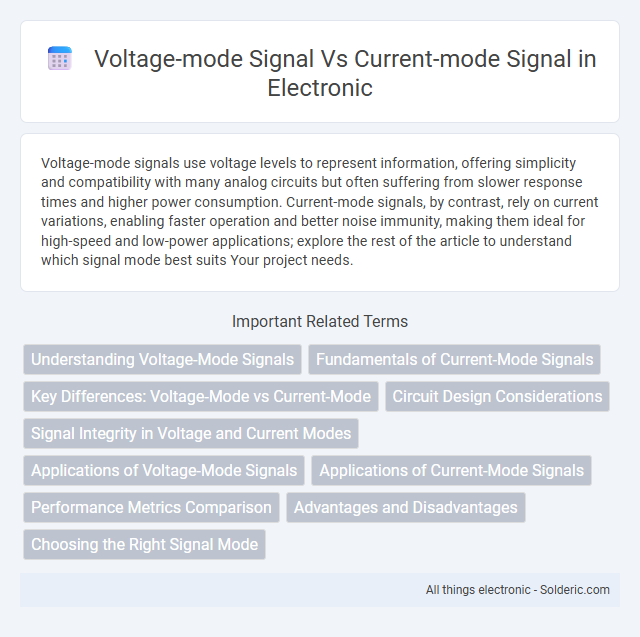Voltage-mode signals use voltage levels to represent information, offering simplicity and compatibility with many analog circuits but often suffering from slower response times and higher power consumption. Current-mode signals, by contrast, rely on current variations, enabling faster operation and better noise immunity, making them ideal for high-speed and low-power applications; explore the rest of the article to understand which signal mode best suits Your project needs.
Comparison Table
| Feature | Voltage-Mode Signal | Current-Mode Signal |
|---|---|---|
| Definition | Signal represented by voltage variations. | Signal represented by current variations. |
| Noise Immunity | Lower; susceptible to voltage noise and interference. | Higher; less affected by voltage noise, ideal for noisy environments. |
| Signal Integrity | Degrades over long distances due to voltage drops. | Maintains integrity over longer cables and higher speeds. |
| Power Consumption | Generally lower power consumption in simple circuits. | Can consume more power due to continuous current flow. |
| Complexity | Simpler circuit design; widely used in analog systems. | More complex design; preferred in high-speed digital applications. |
| Impedance Sensitivity | Highly sensitive; requires impedance matching. | Less sensitive; easier to drive and control. |
| Applications | Audio signals, sensors, low-frequency analog circuits. | Communication systems, high-speed data links, optical interfaces. |
Understanding Voltage-Mode Signals
Voltage-mode signals represent information through variations in voltage levels relative to a reference ground, making them essential in analog circuits and signal processing. These signals are typically easier to measure and interface with sensors and amplifiers due to standardized voltage levels. Understanding voltage-mode signals is crucial for designing stable amplifiers, filters, and communication systems that rely on precise voltage variations for accurate data representation.
Fundamentals of Current-Mode Signals
Current-mode signals represent information through variations in current rather than voltage, enabling faster response times and improved noise immunity in high-frequency applications. Unlike voltage-mode signals, current-mode signaling minimizes voltage swings, reducing power consumption and electromagnetic interference. Your circuit designs benefit from these fundamentals by achieving higher bandwidth and more robust signal integrity in mixed-signal and analog systems.
Key Differences: Voltage-Mode vs Current-Mode
Voltage-mode signals are characterized by their representation through voltage levels relative to a reference point, while current-mode signals rely on current variations to convey information. Voltage-mode circuits typically have higher input impedance, making them sensitive to noise and signal degradation over long distances. Your choice between these modes depends on factors like bandwidth requirements, power consumption, and signal integrity, with current-mode offering advantages in speed and noise immunity.
Circuit Design Considerations
Voltage-mode signal circuits require careful impedance matching and are sensitive to parasitic capacitances, which can degrade signal integrity at high frequencies. Current-mode signals offer improved bandwidth and noise immunity due to lower voltage swings and reduced susceptibility to capacitive loading effects. Your choice should balance power consumption, speed, and complexity based on the specific application requirements and the trade-offs in circuit stability and linearity.
Signal Integrity in Voltage and Current Modes
Signal integrity in voltage-mode signals is primarily influenced by impedance mismatches and capacitive loading, which can cause reflections and signal degradation over long transmission lines. Current-mode signals exhibit superior noise immunity and reduced voltage drop effects, making them more robust against interference and suitable for high-speed or low-voltage applications. The choice between voltage-mode and current-mode signaling significantly impacts signal quality, with current-mode often preferred in integrated circuits and communication systems requiring precise and stable signal transmission.
Applications of Voltage-Mode Signals
Voltage-mode signals are commonly used in analog circuits, communication systems, and sensor interfaces due to their ease of measurement and compatibility with operational amplifiers. Your devices leveraging audio processing, radio frequency transmission, and data acquisition often rely on voltage-mode signaling for accurate and stable signal representation. These signals enable efficient signal conditioning and amplification, making them ideal for applications requiring precise voltage control.
Applications of Current-Mode Signals
Current-mode signals are widely used in high-frequency and analog integrated circuits due to their superior bandwidth and linearity compared to voltage-mode signals. Applications include signal processing in operational transconductance amplifiers, high-speed communication systems, and sensor interfaces where low power consumption and reduced voltage headroom are crucial. Your circuit designs benefit from enhanced noise immunity and faster response times when employing current-mode signaling in these specialized fields.
Performance Metrics Comparison
Voltage-mode signals typically offer higher noise immunity and better linearity, which enhances signal integrity in low-frequency applications. Current-mode signals excel in bandwidth and speed, making them ideal for high-frequency and high-speed data transmission. Your choice between voltage-mode and current-mode signals depends on the critical performance metrics such as signal-to-noise ratio, bandwidth, linearity, and power consumption requirements.
Advantages and Disadvantages
Voltage-mode signals offer high noise immunity and straightforward interfacing with most electronic components, making them ideal for precise and stable signal transmission. Current-mode signals provide faster response times and improved bandwidth, which are advantageous in high-speed applications but can be more susceptible to noise and require specialized circuitry. Your choice depends on the specific performance criteria of your system, balancing noise tolerance against speed and frequency response.
Choosing the Right Signal Mode
Choosing the right signal mode depends on factors such as noise immunity, bandwidth, and power consumption. Voltage-mode signals are preferred in low-impedance environments where signal integrity and easier interfacing with analog circuits are critical. Current-mode signals excel in high-frequency applications with long-distance transmission due to better noise rejection and reduced electromagnetic interference.
Voltage-mode signal vs current-mode signal Infographic

 solderic.com
solderic.com